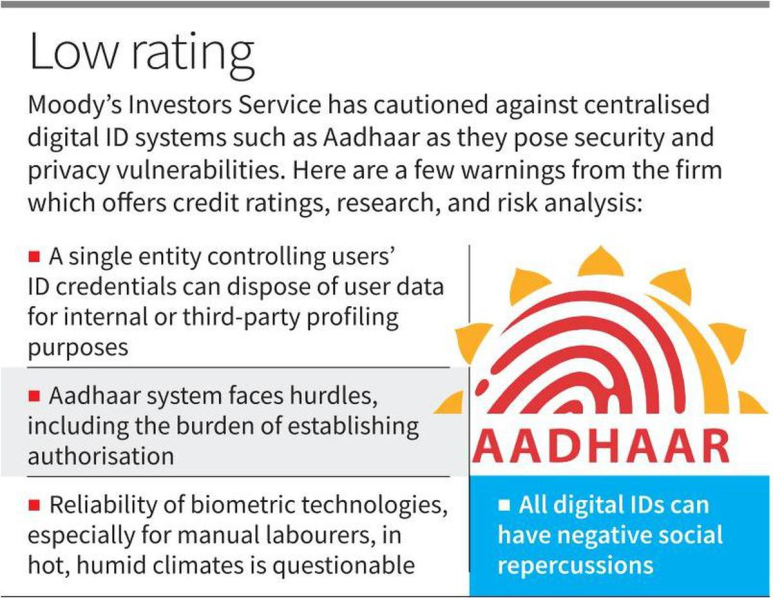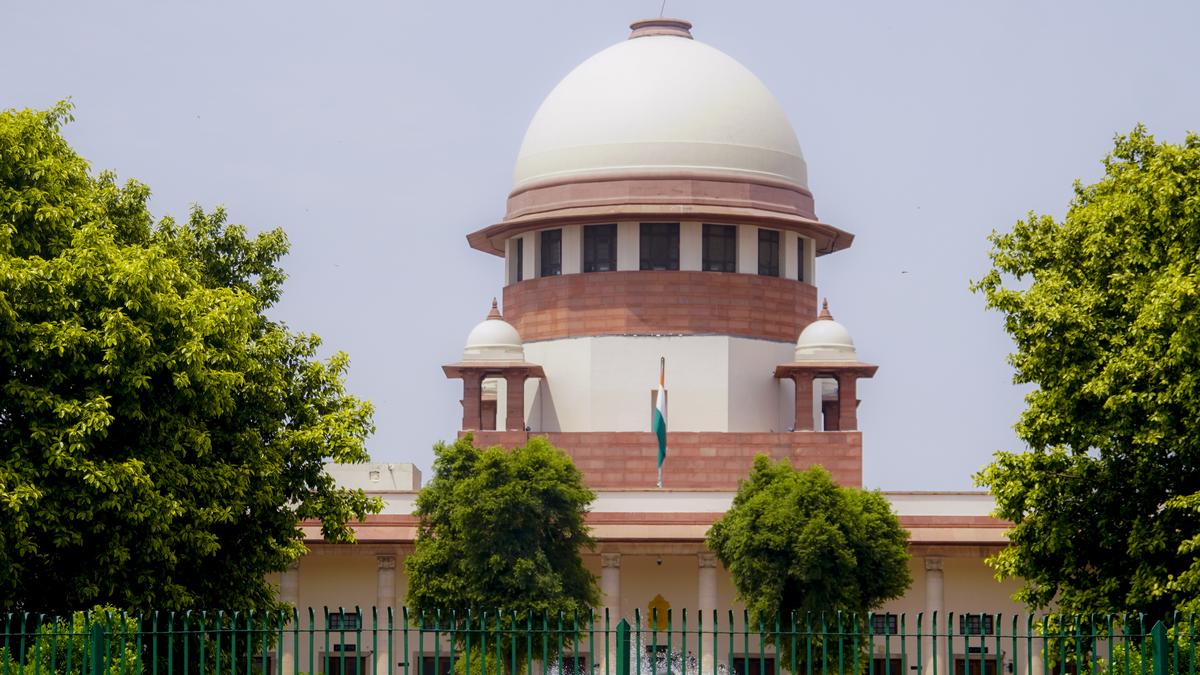Description

Copyright infringement not intended
Picture Courtesy: timesofindia
Context: Global rating agency Moody's Investors Service has raised concerns about the reliability of biometric technologies used in Aadhaar, especially in hot and humid climates, and the resulting service denials. The Indian government has vehemently rejected Moody's claims, defending Aadhaar's integrity and its role as the most trusted digital ID in the world.
Moody's Concerns about Aadhaar
- Moody's, a global rating agency, has voiced concerns about India's Aadhaar program, the world's largest digital ID initiative. They acknowledge Aadhaar's mission to grant access to public and private services via biometric verification methods such as fingerprints, iris scans, and One-Time Passcodes.
- Authorization Burden: Moody questions the administrative load of establishing authorization within the Aadhaar system. This suggests concerns about the efficiency and complexity of the authorization process.
- Biometric Reliability: Moody's expresses scepticism regarding the dependability of biometric technologies, particularly in the context of manual labourers working in hot and humid environments. This doubt revolves around the ability of biometrics to function accurately under adverse weather conditions.

Indian government counters Moody's claims with the following points:
- Lack of Credible Evidence: The government challenges Moody's assertions by asserting that they lack substantial evidence or data to substantiate their claims. They argue that making sweeping statements without credible proof is unjustified.
- Alternative Biometric Methods: Regarding the efficiency of biometrics in hot and humid climates, the government highlights that Aadhaar offers alternative methods of authentication. These include face and iris authentication, which are not affected by weather conditions, providing a viable solution.
- Biometrics and Hot, Humid Climates: Regarding biometric reliability in hot and humid climates, the government clarifies that Aadhaar seeding in the Mahatma Gandhi National Rural Employment Guarantee Scheme (MGNREGS) database does not require workers to authenticate using biometrics, and payments are made without biometric authentication. They also highlight the availability of contactless biometric submission methods like face and iris authentication, as well as mobile OTP options.
- Security and Privacy: The government emphasizes that there have been no reported security breaches from the Aadhaar database. They underscore the reliability and security of the system, citing the trustworthiness of the technology.
- International Recognition: The government cites positive recognition from international organizations like the IMF and World Bank, emphasizing that these agencies have praised Aadhaar's role. This recognition further bolsters Aadhaar's credibility as a trusted digital ID system.
These concerns hold immense importance for several compelling reasons:
- Dependence on Aadhaar: Aadhaar has emerged as the linchpin of the Indian government's ambitious efforts to modernize and digitize its welfare distribution systems. It serves as the cornerstone that links individuals to an array of vital social and financial services.
- Access to Essential Services: Millions of Indian citizens depend on Aadhaar for access to fundamental services, including subsidized food distribution through the Public Distribution System, LPG gas subsidies, and financial benefits provided under initiatives like the PM Kisan Yojana. Any shortcomings or unreliability in the Aadhaar system can directly disrupt the livelihoods of the country's most vulnerable populations.
- Statistical Magnitude: Nearly 765.30 million Indians link Aadhaar to ration cards and over 280 million residents link it to LPG subsidies. These numbers underscore the sheer scale of Aadhaar's integration into the daily lives of citizens, indicating the vast number of individuals whose well-being is intricately tied to the Aadhaar system.
- Impact on the Marginalized: The reliability concerns are particularly distressing because the individuals who depend on government subsidies and welfare programs are often among the most economically disadvantaged. Any service denials or disruptions due to biometric unreliability could result in dire consequences, including hunger and severe financial hardships.
- National Digital Infrastructure: As Aadhaar increasingly becomes the primary mode of identification, doubts about its reliability cast shadows over the broader digital infrastructure and governance initiatives of the nation. It raises questions about the dependability of the entire ecosystem.
Steps to enhance the efficiency of Aadhaar
- Biometric Technology Enhancement: Invest in research and development to improve the reliability of biometric technologies, particularly in challenging environmental conditions like hot and humid climates. Continuously update and upgrade biometric hardware and software to reduce authentication errors and ensure accurate identification.
- Alternative Authentication Methods: Promote and expand the use of alternative authentication methods such as face recognition, iris scanning, and mobile OTP to reduce reliance on fingerprint-based verification.
- User Education: Conduct widespread awareness campaigns to educate Aadhaar users on proper biometric enrollment techniques, emphasizing the importance of clear and accurate fingerprints during registration.
- Offline Authentication: Develop and deploy systems that allow for offline authentication, particularly in remote areas with unreliable internet connectivity.
- Regular Maintenance and Calibration: Establish a robust maintenance and calibration schedule for biometric devices to ensure their optimal functioning over time.
- Privacy and Security Measures: Strengthen security measures to safeguard Aadhaar data against breaches and cyber threats. Continuously update privacy policies and ensure strict adherence to international data protection standards.
- Public Feedback Mechanisms: Establish mechanisms for Aadhaar users to provide feedback and report issues with the system, enabling prompt resolution of problems.
- Collaboration with Technology Experts: Collaborate with technology experts, both domestic and international, to gain insights into best practices for biometric authentication in challenging conditions.
- Capacity Building: Invest in training programs for Aadhaar operators and administrators to ensure they are well-equipped to manage the system efficiently.
- Research and Development Grants: Allocate funding for research and development projects aimed at advancing biometric technology and addressing specific challenges unique to Aadhaar.
- Continuous Monitoring: Implement a comprehensive monitoring system to track the performance, reliability, and security of Aadhaar on an ongoing basis.
.jpg)
Conclusion
- Addressing the reliability concerns surrounding India's Aadhaar program is vital, given its central role in delivering government welfare services. While the government's defence highlights its widespread usage and international recognition, these concerns should not be underestimated. Enhancing biometric technology, data security, and privacy measures, along with user education, is crucial to maintaining Aadhaar's efficiency and trustworthiness as a digital ID system in India.
Must Read Articles:
AADHAR AMBIT: https://www.iasgyan.in/daily-current-affairs/aadhar-ambit
|
PRACTICE QUESTION
Q. In light of Moody's concerns about the reliability of biometric technologies in India's Aadhaar program, how is the Indian government addressing these challenges, and what steps are being taken to enhance the efficiency and dependability of the Aadhaar system, especially in hot and humid climates?
|
Array
(
[0] => daily-current-affairs/moodys-report-on-aadhaar-biometrics
[1] => daily-current-affairs
[2] => moodys-report-on-aadhaar-biometrics
)










